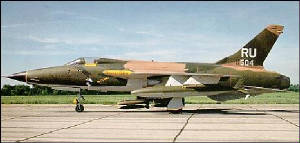|
In 1963, the U.S. Air Force began a program to modify
the AD-5 Skyraider for service in Vietnam and redesignated it the A-1E. Because of its ability to carry large bomb loads,
absorb heavy ground fire, and fly for long periods at low altitude, the A-1E was particularly suited for close-support missions.

Specifications
- Span: 50 ft. 1/4 in.
- Length: 40 ft.
- Height: 15 ft. 9 5/8 in.
- Weight: 24,782 lbs. maximum
- Armament: Four 20mm cannons and a wide assortment
of bombs, rockets, mines, grenades, flares and gun pods
- Engine: Wright R-3350 of 2,700 hp.
- Cost: $414,000
Performance
- Maximum speed: 325 mph.
- Cruising speed: 240 mph.
- Range: 1,500 miles
- Service Ceiling: 26,200 ft.
F-100 SUPER
SABRE
A fighter bomber, the F-100 Super Sabre
saw action in Vietnam from the early 1960s until it was withdrawn in 1970. It could carry almost four tons of bombs, and was
armed with air-to-air missiles, and four twenty millimeter cannons. It was used in ground-support to attack road junctions,
bridges and concentrations of troops. 
|
 |
The
F-4 During this deployment, called
Operation Constant Guard, the 49th flew more than 21,000 combat hours over just about every battle zone from An Loc to vital
installations in the Hanoi vicinity. During five months of combat, the wing did not lose any aircraft or personnel -- a testament
to the outstanding training and proficiency of all members of the 49th. The unit officially closed out its Southwest Asia
duty Oct. 6, 1972, and received an Air Force Outstanding Unit Award with Combat "V" Device for its participation. (Military.com)

B-52
|
The B-52 set many
records in its 25-plus years of service. On Jan. 18, 1957, three B-52Bs completed the world's first non-stop round-the-world
flight by jet aircraft, lasting 45 hours and 19 minutes with only three aerial refuelings en route. It was also a B-52 that
made the first airborne hydrogen bomb drop over Bikini Atoll on May 21, 1956. In June 1965, B-52s entered combat when they
began flying missions in Southeast Asia. By Aug. 1973, they had flown 126,615 combat sorties with 17 B-52s lost to enemy action.

Specifications
- Span: 185 ft.
- Length: 156 ft. 6 in.
- Height: 48 ft. 4 in.
- Weight: 450,000 lbs. max.
- Armament: Four .50-cal. machine guns in tail plus
bombs--nuclear or 43,000 lbs. of conventional
- Engine: Eight Pratt & Whitney J57s of 12,100 lbs.
thrust ea. with water-alcohol injection
- Cost: $7,000,000
Performance
- Maximum speed: 638 mph.
- Cruising speed: 526 mph.
- Range: 8,338 miles unrefueled
- Service Ceiling: 49,400 ft.
|
 |

F-105 Thunder Chief Orignally designed as a supersonic long range nuclear bomber, the F105 could carry up to five
tons of bombs.
From 1965 - 1970 the Thunder Chief did
most of the Air Forces bombings in Vietnam, typically carrying a cargo of eight 750 pound bombs. Though primarily an attack
aircraft over Vietnam the F105 shot down several MiG 17s and MiG 21s.
|

